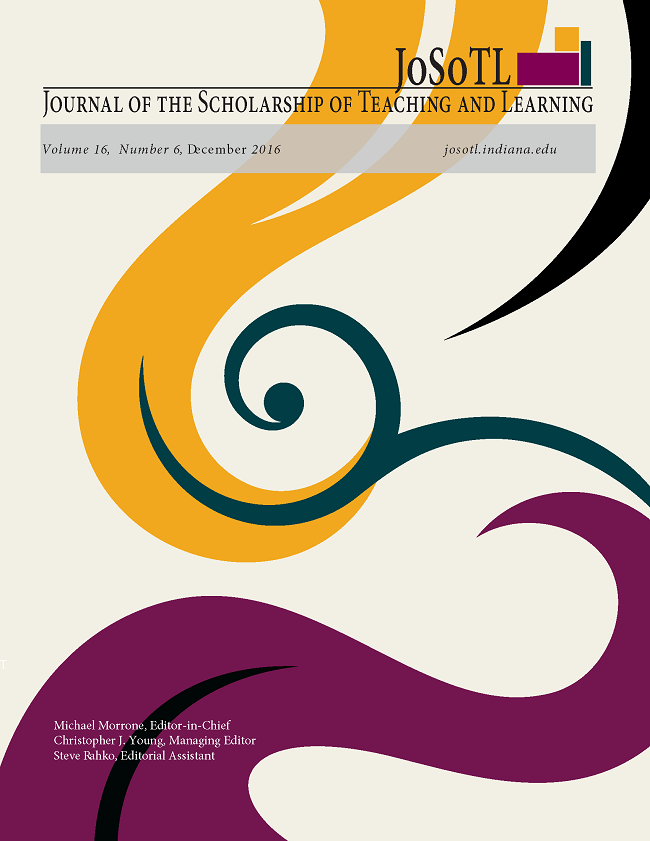Utilizing Shulman’s Table of Learning to Understand Learning in Professional Health Science Programs
Main Article Content
Abstract
Downloads
Article Details
- Authors retain copyright and grant the Journal of the Scholarship of Teaching and Learning (JoSoTL) right of first publication with the work simultaneously licensed under a Creative Commons Attribution License, (CC-BY) 4.0 International, allowing others to share the work with proper acknowledgement and citation of the work's authorship and initial publication in the Journal of the Scholarship of Teaching and Learning.
- Authors are able to enter separate, additional contractual agreements for the non-exclusive distribution of the journal's published version of the work (e.g., post it to an institutional repository or publish it in a book), with an acknowledgement of its initial publication in the Journal of the Scholarship of Teaching and Learning.
- In pursuit of manuscripts of the highest quality, multiple opportunities for mentoring, and greater reach and citation of JoSoTL publications, JoSoTL encourages authors to share their drafts to seek feedback from relevant communities unless the manuscript is already under review or in the publication queue after being accepted. In other words, to be eligible for publication in JoSoTL, manuscripts should not be shared publicly (e.g., online), while under review (after being initially submitted, or after being revised and resubmitted for reconsideration), or upon notice of acceptance and before publication. Once published, authors are strongly encouraged to share the published version widely, with an acknowledgement of its initial publication in the Journal of the Scholarship of Teaching and Learning.
References
Bragg, A. K. (1976). The socialization process in higher education (ERIC/Higher Education Research Report No. 7). Washington, DC: American Association for Higher Education. (ERIC Document Reproduction Service No. 132909).
Carnevale, A., Cheah, B., and Strohl, J. (2013). Hard Times 2013 College majors, unemployment and earnings: Not all college degrees are created equal. Center on Education and the Workforce: Georgetown University. Retrieved from https://cew.georgetown.edu/wpcontent/uploads/HardTimes2015-Report.pdf
Eraut, M. (2000). Non-formal learning and tacit knowledge in professional work. British Journal of Educational Psychology, 70, 113-136.
Eastern Michigan University Institutional Research and Information Management (IRIM). 2014. Quick facts: trend of fall term. [data file]. Retrieved from: http://irim.emich.edu/quick_facts.php?#
Kibek, P. (2008). The worsening shortage of lab staff: What’s being done to turn it around? Clinical Laboratory News, 34(5), 1-4.
McKinney, K. (2013). Introduction to SOTL in and across disciplines. In The scholarship of teaching and learning in and across disciplines. Bloomington IN: Indiana University Press.
Sabari, J. (1985).Professional socialization: Implications for occupational therapy education. American Journal of Occupational Therapy, 39(2): 96-102.
Schon, D. (1983). The reflective practitioner. How professionals think in action. U.S: Basic Books.
Shulman, L.S. (2002). Making differences: A table of learning, Change, 34(6), 36-44.
Shulman, L. S., & Hutchings, P. (2004). Teaching as community property: Essays on higher education (1st ed.). San Francisco: Jossey-Bass.
Shulman, L.S, & Fenstermacher, G.D. (2008). Foreword. In Sullivan, W.M. & Rosin, M.S. (Eds.), A New Agenda for Higher Education: Shaping a Life of the Mind for Practice, (highlights). New York: Carnegie/Jossey-Bass.
Sullivan, W.M., & Rosin, M.S. (2008). Preface. In Sullivan, W.M. & Rosin, M.S. (Eds.), A New Agenda for Higher Education: Shaping a Life of the Mind for Practice, (highlights). New York: Carnegie/ Jossey-Bass.
Tagg, J. (2010). Dispelling the fog of learning through SOTL, International Journal for the Scholarship of Teaching and Learning, 4(2), 1-7.
Understanding (n.d.). In Merriam Webster Dictionary online. Retrieved from http://www.merriam-webster.com/dictionary/understanding.
U.S. Department of Education, National Center for Education Statistics. (2015). Digest of Education Statistics, 2013 (NCES 2015-011) Retrieved from: http://nces.ed.gov/fastfacts/display.asp?id=37
